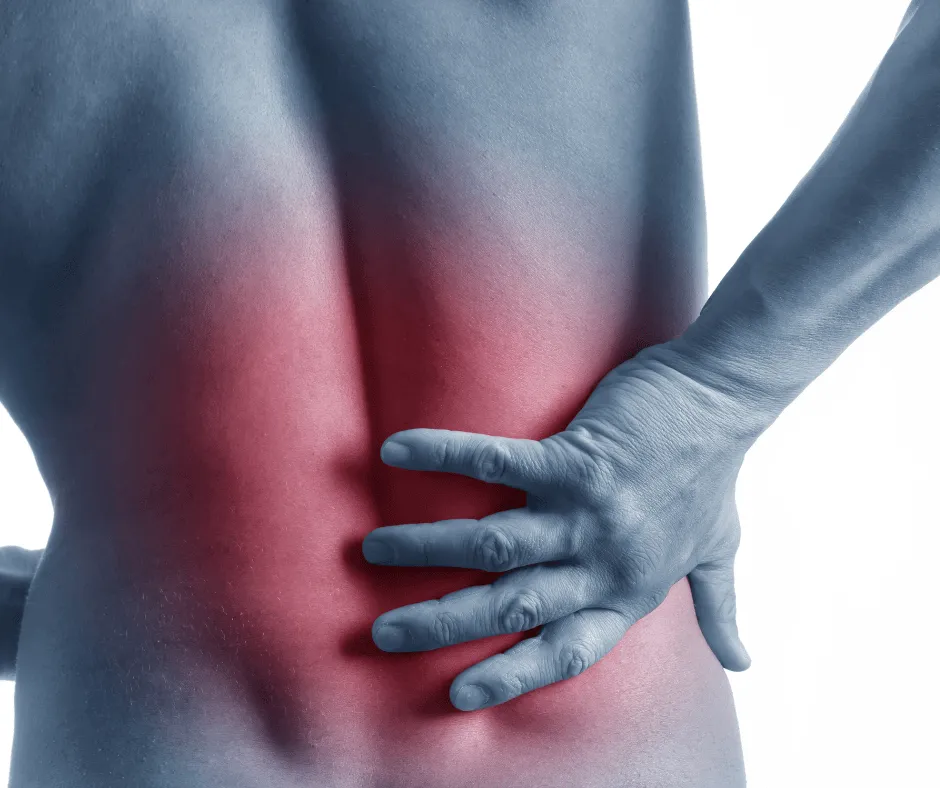Back Pain Relief
Reclaim Your Life, Free from Back Pain
Welcome to your journey towards freedom from back pain. One of the prevalent health issues in the United States is back pain, manifesting itself in various forms ranging from a persistent, mild ache to an abrupt, acute pain that might radiate down your leg. Back pain can be triggered by sudden incidents like accidents, falls, or lifting heavy objects, but it can also gradually develop due to age-induced changes in the spine. Sometimes, medical conditions such as inflammatory arthritis disorders are the culprits behind this pain.
Understanding the intricacy of back pain and its myriad causes, we at PhysioFit advocate for a multi-pronged approach to treatment. With each patient's unique path to relief in mind, we use evidence-based, fitness-centered physical therapy to offer personalized care. Our commitment is not only to alleviate your back discomfort but also to help you adopt measures that enhance your overall well being, thereby reducing the risk of chronic or prolonged pain, and enabling a swift return to your daily activities.
What You Should Know
Acute Back Pain: This is a sudden onset of discomfort that usually lasts from a few days up to a few weeks. Acute back pain is often the result of an accident or sudden physical strain.
Subacute Back Pain: This form of back pain can either come on abruptly or develop gradually over time, typically lasting from 4 to 12 weeks. It may be caused by an injury or overuse of the back muscles.
Chronic Back Pain: Characterized by discomfort lasting more than 12 weeks and occurring daily, chronic back pain may manifest quickly or slowly. It's often associated with degenerative conditions, such as arthritis or disc disease.
A proper diagnosis of a back problem involves a thorough evaluation from a professional.

The Most Common Causes of Back Pain
Back pain can emanate from a diverse array of factors, often intertwining and collectively leading to chronic lower back pain. These factors span mechanical or structural issues with the spine, inflammatory conditions, and other medical disorders. In some instances, it may even be challenging to pinpoint a definite cause for the onset of back discomfort.
Back pain may arise due to mechanical or structural irregularities within the spine, discs, muscles, ligaments, or tendons in the back, or due to nerve compression.
Sprains: These injuries affect the ligaments that provide support to the spine, connecting various bones together. Sprains often occur due to improper twisting or lifting.
Strains: These refer to injuries to a muscle or tendon, which can lead to significant back pain.
Degenerative disc disease: Aging leads to a gradual breakdown of the discs situated between the vertebrae of the spine. This condition is often associated with other degenerative spinal changes, such as arthritis or spinal stenosis.
Herniated or ruptured discs: These conditions occur when a disc compresses and irritates adjacent nerves, usually at the lumbar level but it can also affect the cervical spine.
Spondylolisthesis: This condition is characterized by a vertebra in the spine slipping out of its place or slowly misaligning.
Fractured vertebrae: Fractures of the spinal bones can be a significant source of back pain.
Scoliosis or other congenital changes to the spine: Birth defects and developmental abnormalities like scoliosis can lead to chronic back discomfort.
Myofascial pain: This condition refers to the tightness and pain in the muscles supporting the spine, which could result from muscle damage or from nerve input to the muscles originating from the spine.
As for inflammatory conditions, they also play a significant role in back pain:
Ankylosing spondylitis: This is a specific type of arthritis that affects the spine, causing stiffness and discomfort.
Other Medical Conditions that can cause back pain:
Osteoporosis, Fibromyalgia, Kidney Issues, Endometriosis, Spinal Infections, Tumors, Pregnancy.
Remember, if you resonate with any of the symptoms or conditions mentioned, we highly recommend making an appointment with us for a thorough evaluation and personalized treatment plan.
Proactive Steps for Back Pain Prevention
It's possible to avoid back pain resulting from excessive use or incorrect body movements. Here are some guidelines to foster a healthy back and promote a wholesome lifestyle:
Regular Exercise for a Strong Back: Engage in consistent exercises that fortify your back muscles. Balance-enhancing and strength-boosting activities, like yoga or tai chi, reduce the risk of falls, subsequent back injuries, and bone fractures. Always remember to warm up before any physical activity.
Nutrient-Rich Diet for a Robust Spine: Adopt a healthy diet packed with ample amounts of calcium and vitamin D, the essential nutrients for maintaining spinal strength.
Maintain a Healthy Weight for Stress Reduction: Keep your weight in check. Excess weight can exert unnecessary and harmful stress on your back.
Good Posture for Back Support: Embrace good posture, refraining from slouching. Ensure your back is well-supported while sitting and standing.
Safe Lifting Techniques for Injury Prevention: Evade lifting heavy objects as much as possible. If you have to, rely on your legs and abdominal muscles, not your back.

Common Symptoms of Back Pain
Escalated discomfort when executing lifting or bending movements.
Intensifying pain during rest periods, sitting stances, or when standing.
Rigidity in the morning upon waking, coupled with diminishing back pain upon engaging in activities.
Pain that travels from the back to other areas such as the buttocks, leg, or hip.
Discomfort in your neck, arm, or back
Recurring episodes of back discomfort.
Remember, if you resonate with any of the symptoms or conditions mentioned, we highly recommend making an appointment with us for a thorough evaluation and personalized treatment plan.
Please Note: The information provided on our website is intended for general education and is not a substitute for professional medical advice. Each individual's situation and body is different. Therefore, what may work for one person may not work for another. We care about your well-being and advise you to reach out to us to discuss your specific needs before implementing any advice from our website.
Your Source for All Things Physical Therapy in Bend Oregon
The PhysioBlog

Top 5 Mistakes After Knee Replacement
Top 5 Mistakes After Knee Replacement
Please Note: The information provided on our website is intended for general education and is not a substitute for professional medical advice. Each individual's situation and body are different. Therefore, what may work for one person may not work for another. We care about your well-being and advise you to reach out to us to discuss your specific needs before implementing any advice from our website. If you’d like to explore this more or would like to schedule a time with a physical therapist in Bend Oregon, contact us at PhysioFITBend.com
Introduction
Navigating Knee Replacement Recovery in Bend, Oregon
In Bend, Oregon, knee replacement surgery is more than a medical procedure; it's a journey towards a pain-free, active lifestyle. At PhysioFIT, we understand this journey intimately. While knee replacement can be life-changing, the path to recovery is critical. Missteps can delay healing and impact outcomes. This article explores the top five mistakes to avoid after your surgery, ensuring your recovery is as effective and smooth as possible.
Mistake 1: Overlooking Post-Surgery Lifestyle Adjustments
Preparing Your Home and Life for Recovery
Adapting your living space for post-surgery recovery is crucial. Many patients underestimate the limitations they'll face immediately after surgery. At PhysioFIT, we encourage patients to consider home modifications, such as arranging a ground-floor living space and preparing easy-access meal options. We provide personalized consultations to help our Bend community prepare their homes and lives for the recovery phase.
Mistake 2: Inconsistent Pain Management
Effective Pain Control: A Cornerstone of Recovery
Managing pain is not just about comfort; it's about enabling active participation in rehabilitation. Irregular use of prescribed pain medication can lead to a debilitating cycle of discomfort and hindered mobility. At PhysioFIT, our pain management strategies are tailored to each individual, ensuring a balance between relief and recovery.
Mistake 3: Neglecting Physical Therapy and Exercise
The Role of Rehabilitation in Knee Recovery
Physical therapy is the bedrock of successful knee replacement recovery. Skipping sessions or not fully committing to the exercise regimen can result in stiffness and reduced mobility. Our PhysioFIT experts design customized therapy plans, keeping in mind the unique lifestyles of our Bend clients, ensuring that each step in the therapy process is both manageable and effective.

Mistake 4: Rushing Back into Activities
Finding the Right Pace for Activity Post-Surgery
The eagerness to return to normal life can lead to overexertion, causing setbacks in recovery. Understanding the fine line between necessary activity and overdoing it is essential. Our PhysioFIT team guides patients in gradually resuming activities, balancing rest and movement to foster optimal healing.
Mistake 5: Skipping Pre-Surgery Conditioning
The Impact of Prehab on Recovery Outcomes
Pre-surgery conditioning, or prehab, plays a significant role in enhancing post-surgery recovery. Building strength and flexibility prior to surgery can lead to better post-operative outcomes. Our prehab programs at PhysioFIT are designed to prepare your body for the demands of surgery and speed up the recovery process.
Conclusion
Join PhysioFIT for a Successful Knee Replacement Journey
Avoiding these five common mistakes can significantly influence your recovery after a knee replacement. Remember, each decision and action during your recovery can greatly impact the overall success of your surgery. If you're in Bend, Oregon, and preparing for or recovering from knee replacement surgery, PhysioFIT is here to guide you every step of the way. Visit PhysioFIT or call us to schedule a consultation. Let's work together towards a successful recovery and a return to the active, pain-free life you love.
Frequently Asked Questions
Navigating Common Concerns After Knee Replacement
What is the most commonly reported problem after knee replacement surgery?
The most commonly reported issue is stiffness or limited range of motion in the knee. Regular physical therapy and exercises are crucial to prevent and address this problem.
What can you never do after knee replacement?
High-impact activities such as running, jumping, or contact sports are generally discouraged after a knee replacement as they can put excessive stress on the new joint.
What are the red flags after total knee replacement?
Red flags include severe pain that doesn’t improve with medication, significant swelling, redness around the surgery site, fever, or any signs of infection. Any of these symptoms should prompt immediate medical consultation.
What is the maximum bend after knee replacement?
The goal is typically to achieve a range of motion close to 115 degrees, which is sufficient for most daily activities. However, the maximum bend can vary based on individual factors and the type of replacement used.
Please Note: It's important to note that any exercises or techniques that are shared should be performed under the guidance of a qualified physical therapy expert to ensure correct technique and to prevent injuries. A physical therapist can provide a customized exercise program based on the individual's fitness level, goals, and any existing injuries or conditions. If you’d like to explore this more or would like to schedule a time with a physical therapist in Bend Oregon, contact us at PhysioFITBend.com
Copyright PhysioFIT 2023 . All rights reserved


